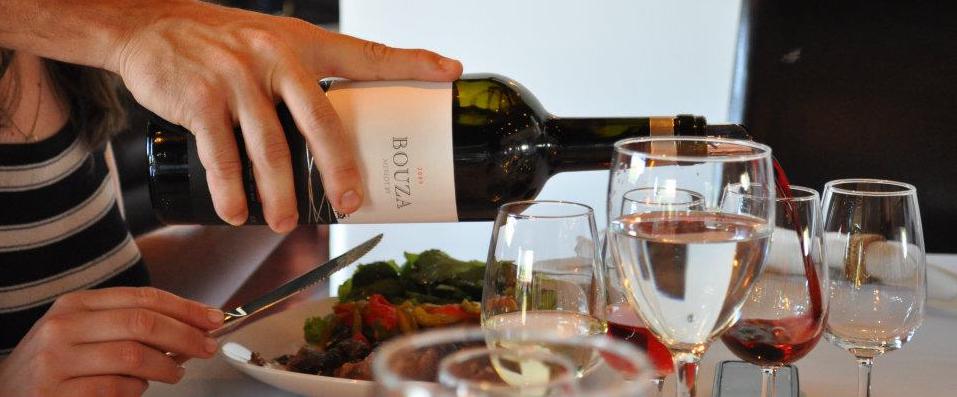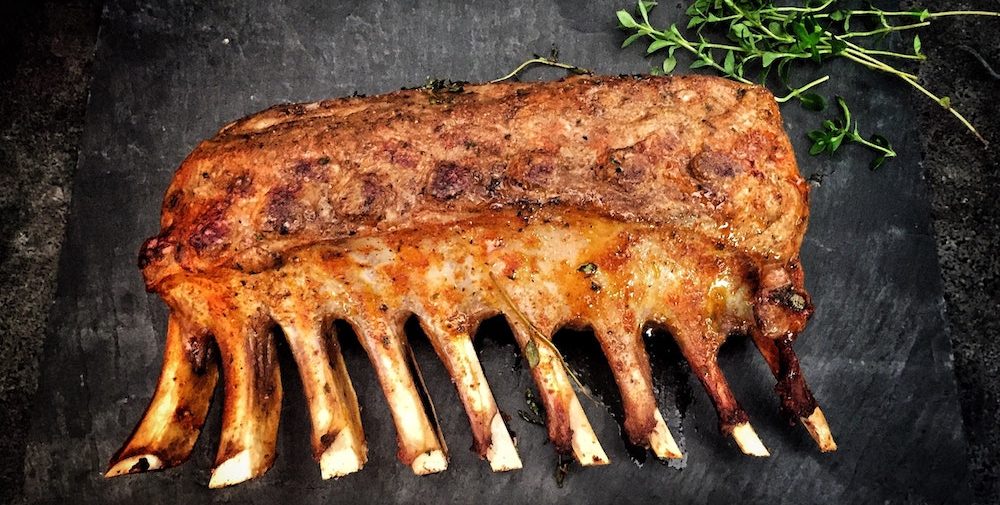Pairing food with Uruguayan wine: A guide to Uruguay wine pairings
When it comes to pairing food with Uruguayan wine, more often than not we are looking at pairing food with Tannat. And the most local and ultimate Uruguay wine pairing is Tannat and beef. Why? Because Uruguay produces more Tannat than anywhere else in the world and consumes more beef than anywhere else in the world.
For such a small country, the numbers are quite staggering. Uruguay produces over a third of the world’s Tannat with some 1,655 hectares planted. But far more staggering, in Uruguay, cows outnumber humans 4 to 1! Uruguayans consume more beef per capita than any other country in the world (at a whopping great 124lbs per person). So the pairing of Tannat and beef comes quite naturally, however, that’s not all Uruguay has to offer in food and wine pairings.
Pairing Tannat wines from Uruguay
Tannat is Uruguay’s champion grape which means it is planted all over Uruguay’s wine regions. With wine regions ranging from coastal to subtropical and over 99 classified soil types in Uruguay, Tannat wines from different vineyards can have quite distinctive styles.
From the heavier clay soils and temperate climate of Canelones, you tend to find much more complex and structured Tannat wines. Whereas Tannat wines from the poor, granitic soils of Maldonado where coastal breezes are cooler, you tend to find Tannat wines that have higher acidity and fresher fruit aromas.
There are also significant differences in winemaking between the different producers in Uruguay. The different uses of oak barrels, stainless steel and concrete tanks all impact the final wine and there are also a great range of harvest times and vinification techniques. In Uruguay, you’ll find bright and juicy Tannats with zero oak influence (including a sparkling Tannat) and you’ll also find dense and complex styles and even dessert wines (including a Tannat Ripasso!)
Different styles of wine = different Tannat food pairings
This all means that Tannat will pair with a range of dishes on the table. Take Pisano‘s Rio de los Pajaros Tannat or Pizzorno‘s carbonic maceration Don Próspero Tannat as an example. These wines are bright, fruit-driven with lively acidity and a tickle of tannin to give some structure. This lighter style of Tannat is enjoyable with red pasta dishes, with charcuterie and lighter meats on the BBQ.
The richer, more complex style of Tannat, from Canelones in particular, which has spent time in barrel – such as Familia Carrau‘s Juan Carrau Reserva or Amat, De Lucca‘s Tannat blends, Marichal‘s Tannat A or Varela Zarranz‘s Guidai Deti blend – needs an altogether stronger pairing. The bold tannins of Tannat deserve a dish with fat and richness, and the dark character of tannat works well with smoky, spiced and meaty flavours. Grilled meats (whether beef, pork, lamb or game) can pair excellently with Tannat wines of this style, as can strong cheeses and wild mushrooms.
The new coastal Tannat wines from Maldonado region tend to have fresher fruit aromas (think red fruit rather than black) and some brightness in the palate, often accompanied by winemaker preferences to use concrete over oak. Good examples of this would be the Tannat wines of Bodega Garzón, Familia Deica‘s Valle de los Manantiales and Bouza‘s Tannat from Pan de Azucar.
These Tannat wines are energetic with vibrancy in the palate and nose and are versatile for food pairings. These wines pair particularly well with flavourful meats without as much fat (like roast lamb cutlets, fillet steak and duck) and work nicely with hard, aged cheeses.
Pairing other Uruguayan wines with food
Of course, Uruguay doesn’t only have Tannat on the table. There’s a wide range of different varieties grown in Uruguay which have been brought from different European immigrants over the years. Uruguay is a country of small, family wineries and each family has brought different varieties from different regions around the world where they have family bonds.
You’ll find Arneis (Viñedo de los Vientos), Zinfandel (Artesana), Nero d’Avola (De Lucca), Albariño (Bouza), Petit Mensang (Bodega Cerro Chapeu), Sangiovese (Viña Progreso), Verdejo (El Capricho)… the list goes on! Often these different varieties are blended with Tannat – for example, Marichal makes a great Pinot Noir-Tannat blend, and Alto de la Ballena blends their Tannat with Viognier and Cabernet Franc in different wines.
Each wine obviously has its own personality and needs a customised pairing. However, here are some of my favourite pairings for Uruguayan dishes with some Uruguayan wines:
Some key pairings for Uruguayan food with Uruguayan wine
Wine pairing for Asado
 The national dish in Uruguay is also number one in most South American countries! Translating as BBQ, the Uruguayan asado almost always carries beef and usually with some sausages or other meats thown in.
The national dish in Uruguay is also number one in most South American countries! Translating as BBQ, the Uruguayan asado almost always carries beef and usually with some sausages or other meats thown in.
Juicy meat that’s dripping with fat and smokey from the coals is crying out to be paired with a good Tannat. Try a more complex style of Tannat (see recommendations above).
What to drink with Uruguayan Chivito
 Not to be confused with chivito in Argentina (meaning goat), a chivito in Uruguay is a steak sandwich – usually garnished with fresh tomatoes and lettuce, a splodge of mayo, and sometimes cheese, ham and/or a fried egg. It’s the ultimate guilty pleasure and more often than not you’ll eat it at lunch time or early evening. My favourite wine pairing for chivito is a light tannat (see recommendations above) or try Marichal‘s Pinot Noir-Tannat or Viña Progreso‘s Sangiovese.
Not to be confused with chivito in Argentina (meaning goat), a chivito in Uruguay is a steak sandwich – usually garnished with fresh tomatoes and lettuce, a splodge of mayo, and sometimes cheese, ham and/or a fried egg. It’s the ultimate guilty pleasure and more often than not you’ll eat it at lunch time or early evening. My favourite wine pairing for chivito is a light tannat (see recommendations above) or try Marichal‘s Pinot Noir-Tannat or Viña Progreso‘s Sangiovese.
A nation of pasta – and the inventor of Cappelletti a la Caruso
 There’s a strong Italian influence in Uruguay, much like neighbouring Argentina, and pasta is usually on the family menu at least once a week. Each pasta will obviously require a different wine pairing, but a typical Uruguayan pasta recipe is with Salsa Caruso.
There’s a strong Italian influence in Uruguay, much like neighbouring Argentina, and pasta is usually on the family menu at least once a week. Each pasta will obviously require a different wine pairing, but a typical Uruguayan pasta recipe is with Salsa Caruso.
Caruso pasta sauce is made from cream with nuts, mushrooms, ham and cheese. It is often served with stuffed cappelletti (also spelt capeletis). These small pasta shells are usually stuffed with some sort of meat (normally beef) but it is the sauce that carries most of the flavour and is what you should be pairing with.
For me, this Uruguayan dish calls for one of the excellent Albariño wines coming from Uruguay (try Bouza or Garzón) which offsets the creaminess with its refreshing acidity. Or try an Arneis (Viñedo de los Vientos), a Marsanne (De Lucca) or Petit Mensang (Bodega Cerro Chapeu) for a more complex and full-bodied wine pairing.
–
Uruguayan stews
 A hearty guiso, or stew, is one of the mainstays of the Uruguayan diet in winter. Although every region has their own variation, in general a stew in Uruguay has some kind of meat (usually beef with sausage and bacon), root vegetables, celery and onion. Although you could pair this with a local white wine, the typical wine pairing for guiso in Uruguay is red wine. My pick would be one of Uruguay’s Marselan wines (try Garzón, Juanico, or Traversa‘s Marselan blend).
A hearty guiso, or stew, is one of the mainstays of the Uruguayan diet in winter. Although every region has their own variation, in general a stew in Uruguay has some kind of meat (usually beef with sausage and bacon), root vegetables, celery and onion. Although you could pair this with a local white wine, the typical wine pairing for guiso in Uruguay is red wine. My pick would be one of Uruguay’s Marselan wines (try Garzón, Juanico, or Traversa‘s Marselan blend).
Revuelto Gramajo
 Revuelto Gramajo is a popular street food dish in Uruguay – fries with scrambled egg, cheese and onion (and some variations in-between). Salty, crispy and gooey in parts, for me this is served best with sparkling wine or a refreshing Sauvignon Blanc. A beer wouldn’t go amiss here either.
Revuelto Gramajo is a popular street food dish in Uruguay – fries with scrambled egg, cheese and onion (and some variations in-between). Salty, crispy and gooey in parts, for me this is served best with sparkling wine or a refreshing Sauvignon Blanc. A beer wouldn’t go amiss here either.
What are your favourite Uruguayan wine pairings?
On Saturday 9th February, the South America Wine Guide is collaborating on a live Uruguayan Wine Pairing Weekend. You can join the discussion over Twitter and share your favourite pairings for wines from Uruguay.


